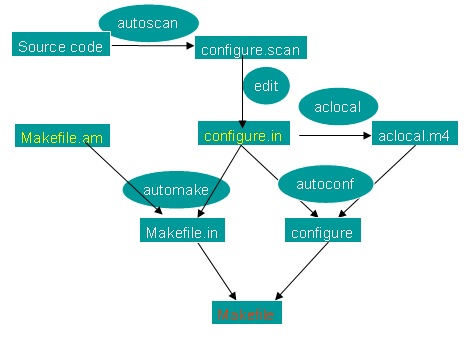|
1
2
3
4
5
6
7
8
9
|
//根据configure.in和Makefile.am生成makefile的步骤,基于UBUNTU 12.04
1.autoscan (可选)
2.aclocal
3.autoconf
4.autoheader(可选)
5.libtoolize --automake --copy --debug --force(可选)
6.automake --add-missing
7.autoreconf –f –i –Wall,no–obsolete(可选)
8../configure
|
简单的方式:
如果拿到的工程文件中,没有Makefile文件,而只有configure.in和Makefile.am文件,我们是不能够直接进行编译的,必须在UBUNTU等Linux系统下,根据configure.in和Makefile.am文件生成编译所需的Makefile文件。具体操作步骤如下:
1、执行autoscan,然后执行aclocal,产生aclocal.m4文件
aclocal是一个perl 脚本程序,它的定义是:“aclocal – create aclocal.m4 by scanning configure.ac”。 aclocal根据configure.in文件的内容,自动生成aclocal.m4文件。而aclocal.m4文件中,包含了生成configure文件所必须的宏。
2、执行autoconf,生成configure文件
autoconf会根据configure.in和aclocal.m4文件,生成configure文件。其实,autoconf就是把configure.in和aclocal.m4文件中定义的内容, 变成检查系统特性、环境变量、软件必须的参数的shell脚本。
3、执行automake命令,产生Makefile.in
具体命令为:automake –add-missing
automake会根据Makefile.am文件产生一些文件,包含最重要的Makefile.in。前面所生成的configure,会根据Makefile.in文件,来生成最终的Makefile文件。
4、执行configure命令,生成Makefile文件
这样,就产生了编译所需要的Makefile文件。运行make,即可编译。
复杂点的方式:
为一个项目源文件生成makefile并make的步骤如下:
操作在包含源文件的项目目录下进行。
- (1)运行autoscan,生成文件configure.scan
- (2)修改configure.scan,改名为configure.in
- (3)运行autoheader,生成文件configure.h.in(现在一般改为configure.ac)
- (4)运行libtoolize,生成ltmain.sh
- (5)运行allocal,生成aclocal.m4
- (6)运行autoconf,生成configure
- (7)运行automake,生成makefile.in,每个包含makefile.am的子目录都生成makefile.in。automake -a选项可以补齐文件config.guess,config.sub,install-sh,missing,depcomp
- (8)运行./configure,生成config.status,config.h,makefile
- (9)运行make,生成中间文件对象文件,库文件,最后生成可执行文件
- (10)运行make install,相应的可执行文件,库文件,头文件拷贝到系统相应位置。
configure运行
configure是一个shell脚本文件,由autoconf生成,它自动为源码包配置编译连接选项,适应不同的硬件平台和POSIX操作系统,输出所需要的Makefile。
configure主管检查你的系统,把结果存放到config.status中,config.status根据它的检查结果实际执行正确的动作。
configure检查与系统相关的一系列变量,这些变量存储到文件config.status中,供makefile调用。这些变量包括编译连接时需要的程序,这些程序在系统中的位置(目录),调用这些程序的选项,比如编译器的目录,编译器的选项-g是否支持等。configure能猜出它运行的系统的规范名字cpu–vendor–os,它通过运行脚本文件config.guess输出变量uname来猜出。configure能识别很多系统名字的别名,它通过运行脚本文件config.sub把系统名字变成规范名字。
make运行
makefile.am对makefile的影响:它根据SUBDIRS = add sub让make递归进入每个子目录处理子目录的Makefile。根据main_LDADD = add/libadd.la sub/libsub.la为main连接libadd.la和libsub.la库。
configure.in对makefile的影响:
根据AC_PROG_LIBTOOL让libtool完成编译连接工作。
根据AC_CONFIG_HEADERS([config.h])只需传递预处理宏-DHAVE_CONFIG_H给编译器。
makefile中很多与系统相关的信息都是通过变量获取的,这些变量之前已经由configure检查好存放在config.status里面,预处理 宏存放在config.h里面。比如我们要用到的编译器CC,编译器选项CFLAGS等。makefile中的变量完成替换后,开始实际执行命令,它会递 归执行每一个子目录下的makefile,生成对象文件,连接库文件,最后连接成可执行文件。
交叉编译 Cross-compiling
Q:为别的平台编译可执行程序怎么做?
交叉编译就是在目前的平台上为别的目标平台生成可执行程序或库。可以在运行configure时通过–build,–host,–target参数实现交叉编译。
例如:
|
1
|
./configure --build=i686-pc-linux-gnu --host=m68k-coff
|
–build=build-type :configure和compile软件包的系统类型。默认情况等于config.guess给出的系统类型
–host=host-type :运行软件包的系统类型。默认情况等于build类型
–target=target-type :很少用,默认情况等于host类型。
交叉编译时,如果编译器,连接器,汇编器名字不是以host_type为前缀,configure都会发出警告。
要搭建交叉变异环境,如交叉编译用的编译器,连接器,汇编器跟本地的不一样,一般以host_type为前缀,如arm-pc-linux-gcc。
安装目录
Q:make install时,文件都安装到哪里去了?
prefix:安装目录的前缀。默认情况下/usr/local 。
bindir:安装时拷贝可执行文件到此目录。默认情况下/usr/local/bin 。
includir:安装时拷贝头文件到此目录。默认情况下/usr/local/include 。
libdir:安装时拷贝库文件到此目录。默认情况下/usr/local/libs 。
定制自己的安装目录,可以–prefix 和 –exec-prefix 给configure。
例如:./configure –prefix=/usr 。
Configure,Makefile.am, Makefile.in, Makefile文件之间关系

|
1
2
3
4
5
6
7
8
9
10
11
12
13
14
15
16
17
18
19
20
21
22
23
24
25
26
27
28
29
30
31
32
33
34
35
36
37
38
39
40
41
42
43
44
45
46
47
48
49
50
51
52
53
54
55
56
57
58
59
60
61
62
63
64
65
66
67
68
69
70
71
72
73
74
75
76
77
78
79
80
81
82
83
84
85
86
87
88
89
90
91
92
93
94
95
96
97
98
99
100
101
102
103
104
105
106
107
108
109
110
111
112
113
114
115
116
|
1.autoscan (autoconf): 扫描源代码以搜寻普通的可移植性问题,比如检查编译器,库,头文件等,生成文件configure.scan,它是configure.ac的一个雏形。
your source files --- [autoscan*] --- [configure.scan] --- configure.ac
2.aclocal (automake):根据已经安装的宏,用户定义宏和acinclude.m4文件中的宏将configure.ac文件所需要的宏集中定义到文件 aclocal.m4中。aclocal是一个perl 脚本程序,它的定义是:“aclocal - create aclocal.m4 by scanning configure.ac”
user input files optional input process output files
================ ============== ======= ============
acinclude.m4 - - - - -.
V
.-------,
configure.ac -------------------------|aclocal|
{user macro files} --| |------- aclocal.m4
`-------'
3.autoheader(autoconf): 根据configure.ac中的某些宏,比如cpp宏定义,运行m4,声称config.h.in
user input files optional input process output files
================ ============== ======= ============
aclocal.m4 - - - - - - - .
|
V
.----------,
configure.ac ------------------------|autoheader|----- autoconfig.h.in
`----------'
4.automake: automake将Makefile.am中定义的结构建立Makefile.in,然后configure脚本将生成的Makefile.in文件转换 为Makefile。如果在configure.ac中定义了一些特殊的宏,比如AC_PROG_LIBTOOL,它会调用libtoolize,否则它 会自己产生config.guess和config.sub
user input files optional input processes output files
================ ============== ========= ============
.--------,
| | - - -- COPYING
| | - - -- INSTALL
| |------- install-sh
| |------- missing
|automake|------- mkinstalldirs
configure.ac ------------------------| |
Makefile.am ------------------------| |------- Makefile.in
| |------- stamp-h.in
.---+ | - - -- config.guess
| | | - - -- config.sub
| `------+-'
| | - - - -- config.guess
|libtoolize| - - - -- config.sub
| |--------- ltmain.sh
| |--------- ltconfig
`----------'
5.autoconf:将configure.ac中的宏展开,生成configure脚本。这个过程可能要用到aclocal.m4中定义的宏。
user input files optional input processes output files
================ ============== ========= ============
aclocal.m4 ,autoconfig.h.in - - - - - - -.
V
.--------,
configure.ac ------------------------|autoconf|------- configure
6. ./configure的过程
.-------------- [config.cache]
configure* --------------------------+-------------- config.log
|
[config.h.in] -. v .--- [autoconfig.h]
+-------> config.status* -+
Makefile.in ---' `--- Makefile
7. make过程
[autoconfig.h] -+--- make* ---- 程序
Makefile ---'
----------
config.site - - --| |
config.cache - - --|configure| - - -- config.cache
| +-,
`-+-------' |
| |----- config.status
config.h.in --------|config- |----- config.h
Makefile.in --------| .status|----- Makefile
| |----- stamp-h
| +--,
.-+ | |
| `------+--' |
ltmain.sh --------|ltconfig|-------- libtool
| | |
`-+------' |
|config.guess|
| config.sub |
`------------'
----------
Makefile -------| |
config.h -------| make |
{project sources} -----------------| |--------- {project targets}
.-+ +--,
| `--------' |
| libtool |
| missing |
| install-sh |
|mkinstalldirs|
`-------------'
|
针对上面提到的 各个命令,我们再做些详细的介绍
//http://www.laruence.com/2009/11/18/1154.html
|
1
2
3
4
5
6
7
8
9
10
11
12
13
14
15
16
17
18
19
20
21
22
23
24
25
26
27
28
29
30
31
32
33
34
35
36
37
38
39
40
41
42
43
44
45
46
47
48
49
50
51
52
53
54
55
56
57
58
59
60
61
62
63
64
65
66
67
68
69
70
71
72
73
74
|
1. autoscan
autoscan是 用来扫描源代码目录生成configure.scan文件的 .autoscan
可以用目录名做为参数,但如果你不使用参数的 话,那么autoscan将认为使用的是当前目录.
autoscan将扫描你所指定目录中的 源文件,并创建configure.scan文件.
2. configure.scan
configure.scan包含了系统配置的 基本选项,里面都是 一些宏定义.我们需要将它改名为
configure.in
3. aclocal
aclocal是 一个perl 脚本程序.aclocal根据configure.in文件的 内容
,自动生成aclocal.m4文件.aclocal的 定义是 :"aclocal - create
aclocal.m4 by scanning configure.ac".
4. autoconf
autoconf是 用来产生configure文件的 .configure是 一个脚本,它能设置
源程序来适应各种不同的操作系统平台,并且根据不同的 系统来产生合适的 Makefile,从而可以使
你的源代码能在不同的操作系统平台上被编译出来.
configure.in文件的 内容是 一些宏,这些宏经过autoconf 处理后会变成检查系统
特性.环境变量.软件必须的 参数的 shell脚本.configure.in文件中的 宏的 顺序并没
有规定,但是 你必须在 所有宏的 最前面和最后面分别加上AC_INIT宏和AC_OUTPUT宏.
在 configure.ini中:
#号表示注释,这个宏后面的 内容将被忽略.
AC_INIT(FILE)
这个宏用来检查源代码所在 的 路径.
AM_INIT_AUTOMAKE(PACKAGE, VERSION)
这个宏是 必须的 ,它描述了我们将要生成的 软件包的 名字及其版本号:PACKAGE是软件包
的名字,VERSION是 版本号.当你使用make dist命令时,它会给你生成一个类似
helloworld-1.0.tar.gz的 软件发行包,其中就有对应的 软件包的 名字和版本号.
AC_PROG_CC
这个宏将检查系统所用的 C编译器.
AC_OUTPUT(FILE)
这个宏是 我们要输出的 Makefile的 名字.
我们在 使用automake时,实际上还需要用到其他的 一些宏,但我们可以用aclocal 来帮
我们自动产生.执行aclocal后我们会得到aclocal.m4文件.
产生了configure.in和aclocal.m4 两个宏文件后,我们就可以使用autocon
f来产生configure文件了.
5. Makefile.am
Makefile.am是 用来生成Makefile.in的 ,需要你手工书写.Makefile.
am中定义了一些内容:
AUTOMAKE_OPTIONS
这个是 automake的 选项.在 执行automake时,它会检查目录下是 否存在 标准
GNU软件包中应具备的各种文件,例如AUTHORS.ChangeLog.NEWS等文件.
我们将其设置成foreign时,automake会改用一般软件包的 标准来检查.
bin_PROGRAMS
这个是 指定我们所要产生的 可执行文件的 文件名.如果你要产生多个可执行文件,
那么在各个名字间用空格隔开.
helloworld_SOURCES
这个是 指定产生"helloworld"时所需要的 源代码.如果它用到了多个源文件,
那么请使用空格符号将它们隔开.比如需要helloworld.h,helloworld.c那么请写成:
helloworld_SOURCES= helloworld.h helloworld.c.
如果你在 bin_PROGRAMS定义了多个可执行文件,则对应每个可执行文件都要定义相对的
filename_SOURCES.
6. automake
我们使用automake --add-missing来产生Makefile.in.
选项--add-missing的 定义是 "add missing standard files
to package",它会让automake加入一个标准的 软件包所必须的 一些文件.
我们用automake产生出来的 Makefile.in文件是 符合GNU Makefile惯例
的 ,接下来我们只要执行configure这个shell 脚本就可以产生合适的 Makefile 文
件了.
7. Makefile
在 符合GNU Makefiel惯例的 Makefile中,包含了一些基本的 预先定义的 操作:
make
根据Makefile编译源代码,连接,生成目标文件,可执行文件.
make clean
清除上次的 make命令所产生的 object文件(后缀为".o"的 文件)及可执行文件.
make install
将编译成功的 可执行文件安装到系统目录中,一般为/usr/local/bin目录.
make dist
产生发布软件包文件(即distribution package).这个命令将会将可执行文件及相关
文件打包成一个tar.gz压缩的 文件用来作为发布软件的 软件包.
它会在 当前目录下生成一个名字类似"PACKAGE-VERSION.tar.gz"的 文件.PA
CKAGE和VERSION,是 我们在 configure.in中定义的 AM_INIT_AUTOM
AKE(PACKAGE, VERSION).
make distcheck
|
错误处理:
When try to configure an open source code, I get error like this :
configure: error: cannot find install-sh, install.sh, or shtool in “.” “./..” “./../..”
<pre>
</pre>
“Libtool library used but ‘LIBTOOL’ is undefined”
<pre>sudo apt-get install autoconf
sudo apt-get install automake
sudo apt-get install libtool
重新执行aclocal/autoheader</pre>
required file build/ltmain.sh' not found
$ automake --add-missingbuild/ltmain.sh’ not found
....
configure.in:18: required file
….
解决方案(libtoolize配置即可):
$libtoolize –version
-libtoolize (GNU libtool) 1.4.2
…..
$libtoolize –automake –copy –debug –force